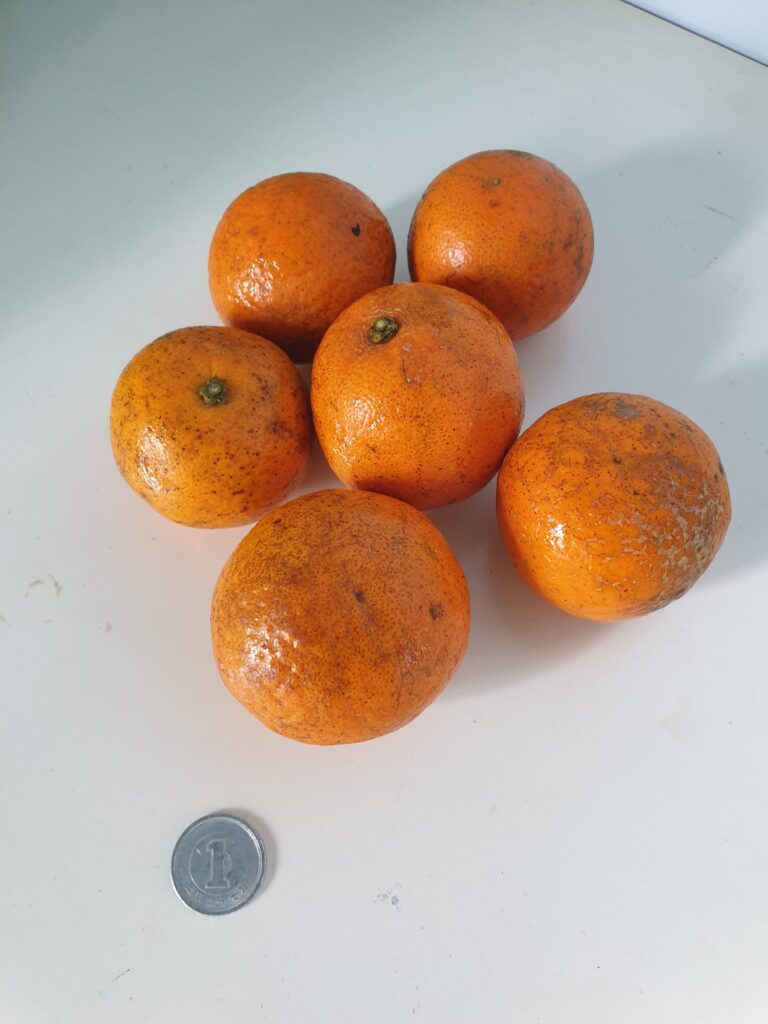It is a variety of tangor, which is a natural hybrid of the navel orange Citrus sinensis and the unknown type of Sunki mandarin (Shimizu, 2016).
The name in Chinese 桶柑 (Tǒng gān) means “barrel citrus”, which is said to be based on the fact that peddlers in China carried it in wooden tubs. Tankan originated in Guangdong province in China and made its way to Xinzhuang in northern Taiwan in 1789. It was transplanted to Japan from Taiwan around 1896 to the Nansei Islands, including Amami Oshima. Economic profitable cultivation in Japan began around 1939. In 2003, 6,880t was harvested in Japan. In Taiwan, production in 2015 was 52,023 tons.
Currently, the main growing areas are Guangdong and Fujian provinces in China, central and northern Taiwan, Yakushima and Amami Oshima in Kagoshima Prefecture in Japan, and Okinawa Prefecture.
Tankan prefers high temperatures and humid summers with an average annual temperature of 19 to 22 degrees Celsius. Flowering time is around April, and harvest time is in January.
Sunki (Citrus sunki), Rangpur (Citrus limonia), Tachibana (Citrus tachibana) and sweet orange (Citrus sinensis) are used as rootstocks. It is grown only in certain areas because its fruit is not always of good quality. Only in warm southern areas does it produce sufficiently large fruit. It is also resistant to wind and tidal damage, so it is relatively easy to grow even in areas prone to typhoon damage. In recent years, its cultivation has expanded in Okinawa and Kagoshima prefectures, as it meets consumer needs and is in high demand there. Tankan is not very hardy, and in Kagoshima Prefecture it is therefore grown commercially in colder areas also in cold greenhouses.
The tree initially grows relatively upright until it gradually becomes bushy at maturity. The branches are short and thin and almost spineless. The flowers are smaller, grow in clusters and are self-pollinating. The fruits are spherical and weigh about 150 g. The skin of the fruit is usually orange-yellow, but the colour varies depending on the variety and the area of production. The skin is relatively thin (3-4 mm) and the skin is adherent but easy to peel. The number of segments in the fruit is about 9.
At the time of harvest, the sugar content is slightly lower than that of Ponkan and the acidity is slightly higher or about the same. The flesh is soft and juicy. There are few seeds and some fruits are seedless. The seeds are polyembryonic and their colour is white when cut (J-FEC, 2024-2).
The fruit is eaten fresh, processed into fruit juice with the peel to give it a slight bitterness (Ryukyu Shimpo, 2023), or made into sorbet, ice cream, jelly and other sweets. The grated peel is used as a seasoning to flavour chicken rice. It can also be candied. Tankan fruit is also used to make a liqueur in Amami Oshima, which is sold as ‘Tankan sake’.

